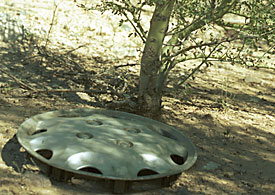 |
|
ALYSON GROVE/Arizona Daily Wildcat
|
A hubcap sits in a desolate area of the Tumamoc Landfill. UA has until March to decide whether it will buy the land, which would be preserved for research.
|
|
By Jesse Greenspan
Arizona Daily Wildcat
Monday September 23, 2002
The UA will acquire 320 acres of land west of Interstate 10 that contains a landfill still being tested for contaminants, in order to preserve nearby ongoing studies of the desert ecosystem.
"There were serious issues regarding the old landfill," said Richard Elias, a member of the Pima County Board of Supervisors. "Until we resolved that, we could not talk seriously about purchasing it."
Two years ago, UA nearly became the owner of 320 acres of land near Tumamoc Hill, a site that houses the Desert Laboratory, a project run by the university in accordance with the United States Geological Survey to survey the desert.
However, a 20-acre landfill on the site scared off Pima County and the Growing Smarter Trust Land Acquisition Grant Program, which were initially willing to purchase the site for the university.
Instead of giving up on the idea, Steve Holland, director of risk management and safety at the UA, organized tests at the landfill to make sure the university was not inheriting a liability.
The Arizona Board of Regents approved UA's taking over ownership of the land at its Aug. 16 meeting.
Tests of the land nearby the landfill, which involved the digging of four ground-water monitoring wells, revealed a higher than permissible level of tetrachloroethylene (PCE), a solvent commonly used in dry cleaning, Holland said.
However, its presence should not be a threat to anyone, Holland said, because the closest well in use is about 1.5 miles away.
"(The underground contamination) is an issue that will have to be dealt with in the future," Holland said.
Three more wells are being used to monitor the direction and movement of the contaminated ground water.
PCE ingested through drinking water can cause liver problems and an increased risk of cancer, according to the Environmental Protection Agency.
The landfill, which contains 365,000 tons of waste from the UA and city dumped from 1962 through 1966, does not affect the desert study, said Julio Betancourt, the senior scientist for the USGS and an adjunct associate professor of geosciences.
The desert laboratory is on a large hill overlooking the old landfill, which is covered with dirt. The dirt cover is now cracking in places, and old tires and glass soda bottles are evident underneath.
With the first phase of those tests now completed, it appears the plans to buy the 320 acres will go through this time around.
"It looks like the situation is well-secured," Betancourt said. "We are currently in the process of securing funds from the county and everyone is on task. Everything should be in place by December."
Overall, the site is expected to cost $2.8 million, with Pima County and Arizona's state park system splitting the cost down the middle.
Because the state park grant of $1.4 million will expire if not used, the UA has until next spring to bid on the land.
For the scientists who depend on the land to run their desert laboratory, the deal will provide a collective sigh of relief.
"This has been a problem on the horizon as long as I've been here," said Betancourt, who has worked at the lab since 1981. "It's been a long and arduous battle · but I'm pleased as punch."
The desert study, located at 1675 W. Anklam Rd. ÷ four miles west of the university ÷ has been going on since 1903, and is one of the longest continual desert studies in the world.
"This is one of the most significant purchases of open space in Pima County, period," Elias said. "It's at the very core of where human beings started living here."
The site is home to big archaeological finds.
Once UA bids on the site, as it is expected to do, Tumamoc Hill will remain out of the grasp of developers, Betancourt said, assuring the existence of the desert lab for decades to come.
"It's out of our hands," said Jim Barry, executive assistant to Chuck Huckleberry, the county administrator who is responsible for gathering the funds. "It's up to the university now."
The 320 acres in question comprises 40 percent of the desert lab property, and will be added to the 549 acres the UA already bought in 1956 that the desert laboratory sits on.
Before 1996, UA rented the land for a few thousand dollars a year, but that all changed when it was reclassified as a conservation area under the Arizona Preserve Initiative.
This initiative was passed to discourage development, and laid out a process for the buying and selling of potential conservation land.
Pima County approved $1.4 million for the purchase in 1997 and the Growing Smarter fund was provided in 2000, when the university would have purchased the site if not for the landfill.

